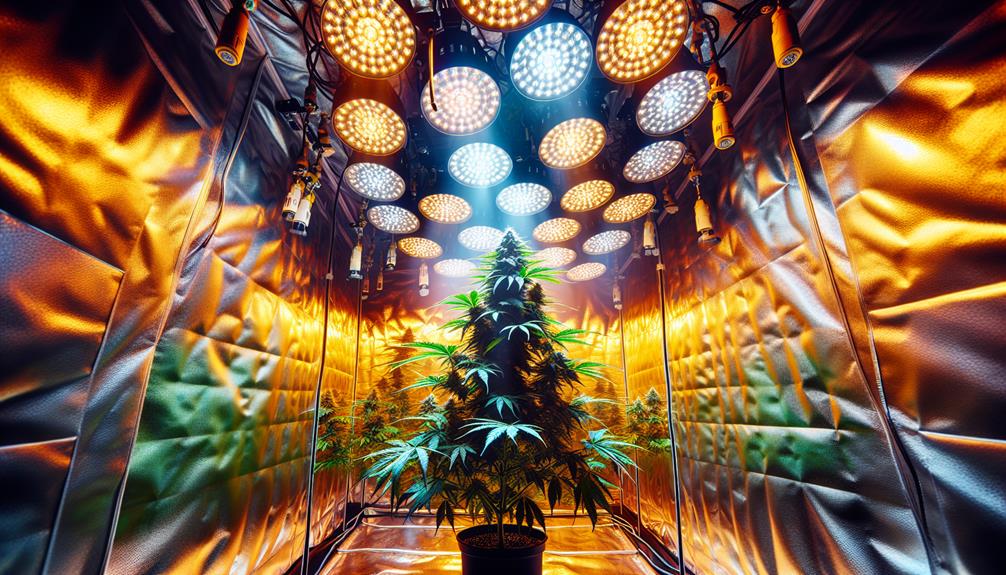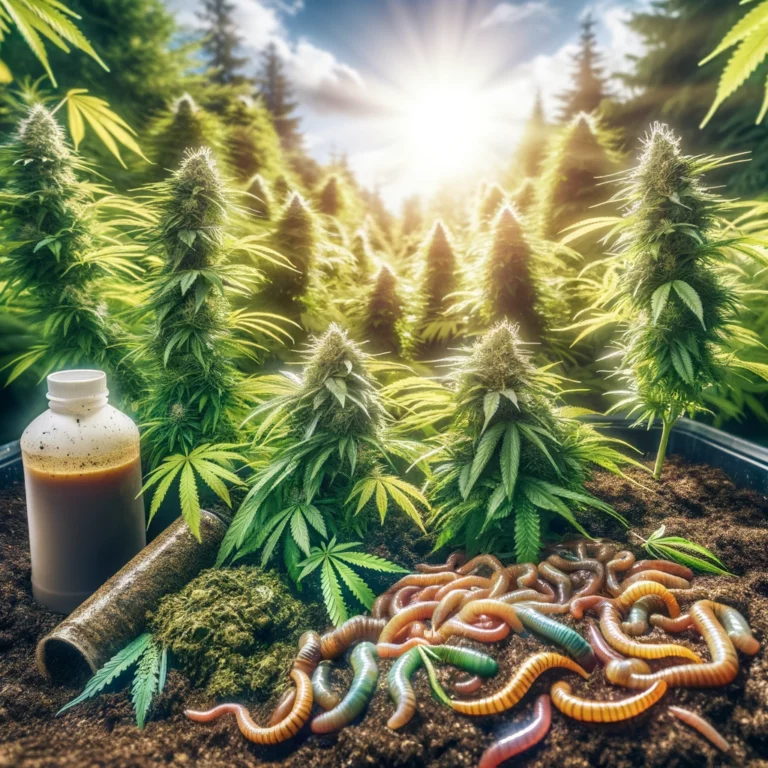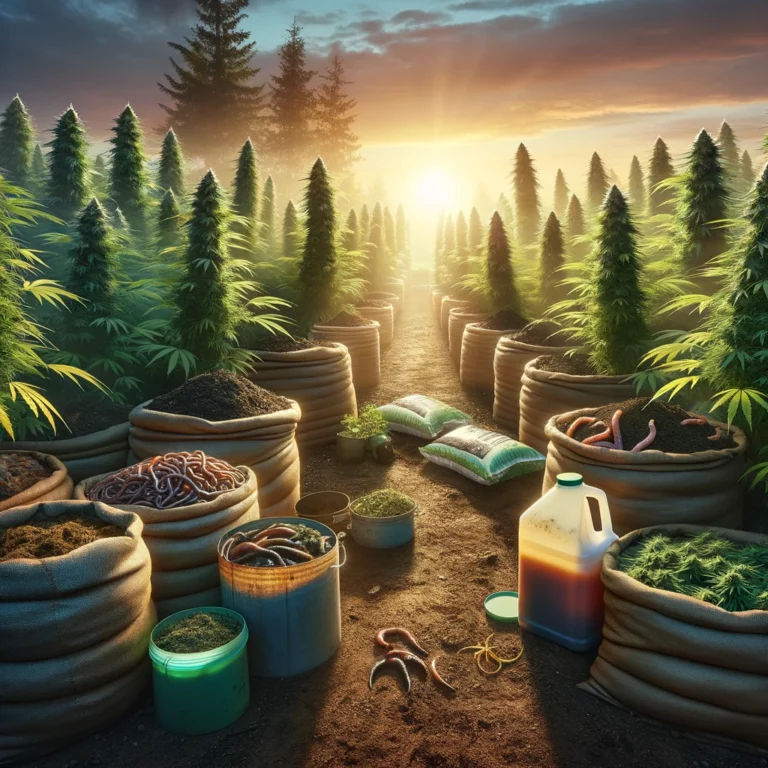When it comes to cultivating your indoor cannabis garden, selecting the right lighting setup is like choosing the perfect brush to paint a masterpiece. The spectrum, intensity, and timing of light exposure are all crucial factors to consider.
But how do you navigate through the multitude of options available and pinpoint the ideal setup for your plants’ growth and health? Let’s shed some light on this topic and unravel the mystery behind achieving the best indoor cannabis lighting setup that will elevate your cultivation game to new heights.
Table of Contents
Here Are the Best Indoor Cannabis Lighting Setup:
Types of Cannabis Grow Lights
When setting up your indoor cannabis grow, choosing the right type of grow lights is crucial. There are several options available, each with its own advantages and considerations. High-intensity discharge (HID) lights, including metal halide (MH) and high-pressure sodium (HPS) lights, have been popular choices for years. They’re known for their high light intensity and are suitable for all stages of plant growth.
LED (light-emitting diode) lights have gained popularity recently due to their energy efficiency and customizable spectrum options. LEDs produce less heat, reducing the need for additional cooling in your grow space.
Fluorescent lights, such as T5 and CFL bulbs, are cost-effective and work well for small grows or seedlings. However, they may not provide enough light intensity for larger plants or flowering stages.
Induction lights are another option known for their longevity and energy efficiency, making them a sustainable choice. Consider factors like your budget, grow space size, and desired yield when selecting the best grow lights for your indoor cannabis cultivation.
RELATED ARTICLE: Guide to Countries With Full Cannabis Legalization
Understanding Light Spectrum for Cannabis
When growing cannabis indoors, understanding the light spectrum is crucial for maximizing plant growth.
The basics of light spectrum, how it affects photosynthesis and overall plant development, and selecting the right bulbs are key aspects to consider.
Light Spectrum Basics
Understanding the light spectrum is crucial for optimizing cannabis growth indoors. Light consists of different colors, each with a specific wavelength. Blue light, around 400-500nm, promotes vegetative growth, while red light, approximately 600-700nm, encourages flowering.
Green light, though less utilized by plants, can penetrate deeper into the canopy. Full-spectrum lights provide a balanced mix of colors to mimic natural sunlight, benefiting overall plant health.
Additionally, ultraviolet (UV) and infrared (IR) light play roles in stimulating certain plant processes. When selecting lighting for your indoor cannabis setup, consider the specific light spectrum requirements for each growth stage to ensure your plants receive the ideal wavelengths for robust growth and maximum yield.
Photosynthesis and Growth
To optimize cannabis growth indoors, it’s essential to understand how the light spectrum influences photosynthesis and plant growth. Different light wavelengths impact various stages of growth. Blue light in the spectrum (400-500 nm) promotes vegetative growth, while red light (600-700 nm) encourages flowering. These wavelengths are absorbed by chlorophyll, the pigment responsible for photosynthesis.
Green light is less efficiently absorbed, so it plays a smaller role in plant development. By providing the right balance of blue and red light, you can mimic the sun’s natural spectrum and enhance photosynthesis. Understanding how different light spectrums affect your plants will help you choose the right lighting setup for optimal cannabis growth indoors.
Choosing the Right Bulbs
For optimal cannabis growth indoors, select bulbs that emit the right balance of blue and red light to mimic the sun’s natural spectrum. When choosing bulbs for your indoor cannabis setup, consider the following:
- Full Spectrum LEDs: Provide a balanced spectrum of light for all growth stages.
- Metal Halide (MH) Bulbs: Emit blue light suitable for vegetative growth.
- High-Pressure Sodium (HPS) Bulbs: Produce red light ideal for flowering stages.
- Fluorescent Bulbs: Offer a cost-effective option for small grows or seedlings.
Choosing the Right Light Intensity
Consider adjusting the light intensity based on the specific growth stage of your cannabis plants.
During the vegetative stage, your plants require a lower light intensity, typically around 400-600 μmol/m²/s. This helps promote healthy leafy growth without risking light burn.
As your plants transition into the flowering stage, gradually increase the light intensity to around 600-1000 μmol/m²/s to support the development of buds. Be cautious not to exceed the recommended light intensity levels, as this can lead to light stress and negatively impact your plant’s health and yield.
It’s crucial to monitor your plants closely and adjust the light intensity as needed. Investing in a light meter can help you accurately measure the light levels and ensure your plants are receiving the right amount of light for their growth stage.
The Importance of Light Schedule
When it comes to optimizing your indoor cannabis growth, the light schedule plays a crucial role.
The light cycle for growth and the impact of light duration are key factors to consider.
Understanding how to manage your light schedule effectively can significantly enhance your plant’s development.
Light Cycle for Growth
Maintaining a consistent light cycle is crucial for the successful growth of indoor cannabis plants. To ensure your plants thrive, follow these key guidelines:
- Consistency: Keep the light cycle consistent throughout the different growth stages.
- Vegetative Stage: During this stage, provide 18-24 hours of light per day to promote healthy leaf and stem growth.
- Flowering Stage: Switch to a 12-hour light and 12-hour dark cycle to trigger flowering.
- Dark Period: Ensure complete darkness during the dark period to avoid light interruptions that can stress the plants.
Following these light cycle practices will help your indoor cannabis plants reach their full potential.
Impact of Light Duration
To optimize the growth of your indoor cannabis plants, understanding the impact of light duration on their development is essential. The amount of light your plants receive directly affects their growth stages.
During the vegetative phase, providing 18-24 hours of light promotes lush foliage and robust stems. However, once you switch to the flowering stage, it’s crucial to adjust the light schedule to 12 hours of light and 12 hours of uninterrupted darkness. This change signals to the plants that it’s time to bloom, leading to the development of buds.
Consistency in your light duration is key to ensuring healthy and productive cannabis plants. By adhering to the appropriate light schedule for each growth phase, you set the stage for a successful indoor cultivation.
Positioning Lights for Maximum Coverage
For optimal coverage, position your lights strategically in your indoor cannabis setup. To ensure your plants receive uniform light distribution, follow these key tips:
- Adjust Height: Maintain the right distance between the lights and the canopy to prevent burning or light deficiency. This distance varies depending on the type of light and the growth stage of your plants.
- Utilize Reflectors: Reflectors can help redirect light towards the lower leaves and sides of your plants, maximizing light absorption and promoting even growth.
- Rotate Lights: Regularly rotate your lights or change their positions to prevent shadows and ensure all parts of your plants receive adequate light exposure.
- Consider Cross Lighting: Position multiple lights at different angles to illuminate the entire canopy and reach light into the lower sections of your plants for improved growth and yield.
Supplemental Lighting Techniques
Enhance your indoor cannabis lighting setup with effective supplemental techniques to boost plant growth and optimize yields. Supplemental lighting can address areas in your grow space that may not be receiving adequate light from your main sources. Consider using reflective materials like Mylar or white paint on walls to bounce light back onto plants. Another technique is using light movers or rotating platforms to ensure even light distribution across all plants.
Additionally, implementing side lighting can help penetrate the canopy and reach lower leaves, stimulating growth throughout the plant. T5 fluorescent lights or LED strips are great options for this purpose. You can also utilize vertical lighting by hanging lights vertically along the sides of your grow space to reach plants from different angles.
LED Vs. HPS Vs. Fluorescent Lights
When comparing LED, HPS, and fluorescent lights for your indoor cannabis setup, consider the specific lighting requirements of your plants and the efficiency of each type. LED lights are energy-efficient and produce less heat, making them ideal for keeping electricity costs down and maintaining a controlled growing environment.
On the other hand, HPS lights are known for their high light intensity, promoting robust flowering during the blooming stage. Fluorescent lights are cost-effective and emit a full spectrum of light suitable for seedlings and young plants.
Here are some key points to consider:
- LED lights have a longer lifespan compared to HPS and fluorescent lights.
- HPS lights are better suited for the flowering stage due to their high light intensity.
- Fluorescent lights are a budget-friendly option for early growth stages.
- LED lights provide better energy efficiency and heat management.
Adjusting Lighting for Different Growth Stages
Considering the different growth stages of your indoor cannabis plants, adjusting the lighting accordingly is crucial for maximizing their development and yield. During the vegetative stage, your plants require around 18 hours of light and 6 hours of darkness daily. LED lights are ideal for this stage due to their energy efficiency and ability to emit the blue spectrum light needed for vegetative growth.
As your plants transition into the flowering stage, they need a 12-hour light and 12-hour dark cycle. Switching to HPS lights during this stage is beneficial as they provide the red and orange spectrum light crucial for flowering. Make sure to adjust the height of your lights as your plants grow to maintain the optimal distance for light absorption.
Tips for Avoiding Light Burn
To prevent light burn on your indoor cannabis plants, ensure you maintain the recommended distance between the lights and the canopy at all times. Light burn can harm your plants and hinder their growth. Follow these tips to avoid light burn:
- Monitor Light Intensity: Keep an eye on the brightness of your lights and adjust accordingly.
- Adjust Light Schedule: Avoid leaving the lights on for too long; stick to a consistent light schedule.
- Use Light Meters: Consider using light meters to measure the intensity reaching your plants accurately.
- Check Plant Responses: Regularly observe your plants for any signs of stress or light burn, such as leaf discoloration or curling.
Frequently Asked Questions
How Do I Calculate the Electricity Costs Associated With Running Indoor Cannabis Grow Lights?
To calculate electricity costs for running indoor cannabis grow lights, multiply the wattage of your lights by the number of hours they are on daily. Then divide the result by 1,000 to get the daily kWh usage.
Can I Use Natural Light as a Supplement to My Indoor Grow Lights?
Yes, you can use natural light as a supplement to your indoor grow lights. Natural light provides additional spectrum and intensity, promoting healthier plant growth. Ensure proper placement and monitor for consistency to maximize benefits.
Are There Any Specific Recommendations for Controlling Humidity Levels When Using Grow Lights?
To control humidity levels when using grow lights, ensure proper ventilation to prevent moisture buildup. Use a dehumidifier if needed. Monitor humidity regularly and adjust airflow as necessary. Maintaining the right humidity levels is crucial for your plants’ health.
What Are the Potential Risks or Dangers of Using Certain Types of Grow Lights?
Using certain types of grow lights can pose risks such as fire hazards, light burn on plants, and increased electricity costs. Be cautious of cheap, unverified brands and always follow safety guidelines for optimal results.
How Do I Properly Dispose of Old or Broken Grow Lights in an Environmentally Friendly Way?
When disposing of old or broken grow lights, recycle them at designated drop-off locations. Check with local recycling centers for proper procedures. Avoid throwing them in regular trash to minimize environmental impact and support sustainable practices.
Conclusion
In conclusion, the best indoor cannabis lighting setup will depend on factors such as the type of grow lights, light spectrum, intensity, schedule, and positioning.
LED lights are energy-efficient and versatile, while HPS lights provide high intensity for flowering. Fluorescent lights can be a budget-friendly option for smaller grows.
Remember to adjust lighting for different growth stages and monitor for signs of light burn to ensure successful cannabis cultivation indoors.



